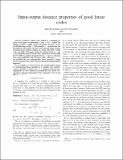Input-Output Distance Properties of Good Linear Codes
Author(s)
Hosseini Roozbehani, Hajir; Polyanskiy, Yury
DownloadAccepted version (156.2Kb)
Terms of use
Metadata
Show full item recordAbstract
Consider a linear code defined as a mapping between vector spaces of dimensions k and n. Let β* denote the minimal (relative) weight among all images of input vectors of full Hamming weight k. Operationally, β* characterizes the threshold for adversarial (erasure) noise beyond which decoder is guaranteed to produce estimate of k-input with 100% symbol error rate (SER). This paper studies the relation between β* and δ, the minimum distance of the code, which gives the threshold for 0 % SER. An optimal tradeoff between β* and δ is obtained (over large alphabets) and all linear codes achieving β* = 1 are classified: they are repetition-like. More generally, a design criteria is proposed for codes with favorable graceful degradation properties. As an example, it is shown that in an overdetermined system of n homogeneous linear equations in k variables (over a field) it is always possible to satisfy some k-1 equations with non-zero assignments to every unknown, provided that any subset of k equations is linearly independent. This statement is true if and only if n ≥ 2k - 1. Keywords: Linear codes; degradation; error correction codes; noise level; null space; hamming weight; error statistics
Date issued
2018-06Department
Massachusetts Institute of Technology. Laboratory for Information and Decision Systems; Massachusetts Institute of Technology. Department of Electrical Engineering and Computer SciencePublisher
Institute of Electrical and Electronics Engineers (IEEE)
Citation
Roozbehani, Hajir and Yury Polyanskiy, "Input-Output Distance Properties of Good Linear Codes," 2018 IEEE International Symposium on Information Theory (ISIT), June 2018, Vail, Colorado, USA, Institute of Electrical and Electronics Engineers (IEEE), August 2018 © 2018 IEEE
Version: Author's final manuscript
ISBN
9781538647813